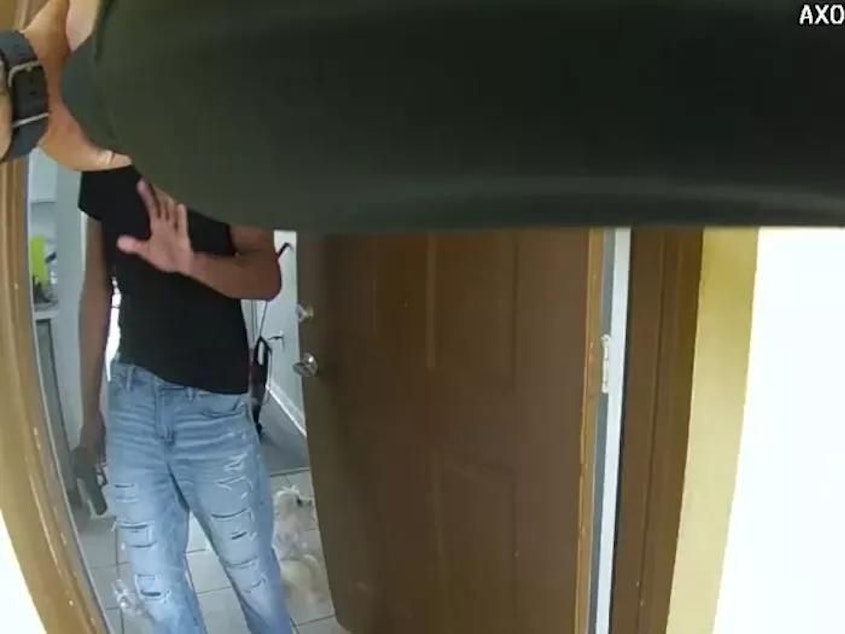Two men killed while pointing guns at the ground. Should police have waited?

The shootings of two men on opposite ends of the country this month have refocused attention on deadly force standards for police -- and how officers should respond to the sight of a gun. In both cases, the men were fatally shot within moments, even as they held their weapons pointed down.
On May 3, “fourth-person” reports of a domestic disturbance at an apartment complex in Okaloosa County, Florida, brought a sheriff’s deputy to the front door of 23-year-old U.S. Airman Roger Fortson, who was alone in his apartment. The deputy’s body camera video shows him pausing to listen at Fortson’s closed door, then knocking, waiting, knocking and again and calling out, “Sheriff’s office, open the door!”
The door opens and Fortson comes into view: a slender African-American man dressed in jeans and standing barefoot on the tiles of his entryway. His left hand is coming up in an open-palm gesture; his right hand is holding a pistol. It’s held loosely, pointed at the floor. In the second it takes him to open the door, the deputy says, “Step back,” unholsters and draws his gun, and fatally shoots Fortson.
“It wasn't a good exchange, he never fired a weapon or anything,” says Benjamin Crump, an attorney. who represents Fortson’s family and appeared at the funeral. “He respected authority,” he says of Fortson.
The Okaloosa Sheriff’s Office initially called the shooting “self-defense,” but the case is now under investigation by the Florida Department of Law Enforcement.
Sponsored
Ten days later, another man holding a gun pointed down was shot and killed by police during a domestic disturbance call, this time in Anchorage, Alaska. The morning after the shooting, Police Chief Bianca Cross said the man, Kristopher Handy, had “raised the long gun towards officers,” but a video released later by one of Handy’s neighbors appears to contradict that. It shows Handy outside the apartment building, walking toward officers with an apparent long gun held roughly parallel with his legs. Like Fortson, Handy was shot within moments of facing the police.
The Anchorage Police Department is investigating; Handy’s family is calling for the release of body camera videos of the incident.The recent deaths have renewed questions about whether police are allowed to shoot someone who’s armed, but not pointing the weapon.
“There is no hard and fast rule as it relates to that,” says Rodney Bryant, a 34-year veteran of the Atlanta Police Department, former chief, and now president of the National Organization of Black Law Enforcement Executives.
Sponsored
“Sometimes you may have a person that’s not pointing that still may pose a significant threat to law enforcement officers,” Bryant says. “But... you can have a very similar situation and it’s clear the person is not a threat.”
No Hard And Fast Rule
What complicates matters for police is the science of human reaction times. At Washington State University, Stephen James runs a lab that studies this by running subjects -- including police officers -- through simulations. Those studies have demonstrated a two-to-three-second disadvantage for officers who wait to have a weapon pointed at them.
“There's no way a human can see the weapon coming up, make a decision about whether or not it's a threat, then decide to press the trigger and then the electrical signal has to go from the brain down the nervous system into the finger,” James says. “If you have to wait for all of that, the other person will get a shot off first.”
Because of this lag, James says officers across the nation are trained that “action will beat reaction.”
Sponsored
But he says that's not an excuse to preemptively shoot anyone holding a gun.
James also takes part in state-mandated reviews of police shootings, and he says police have to keep the law in mind, especially the1 989 U.S. Supreme Court case Graham v. Connor, requiring an officer’s decision to shoot to be judged by a “reasonableness” standard.
“When we look at the totality of the circumstances, is the individual acting in a threatening manner? Are they being compliant or are they being defiant?” Even the location of the person could end up determining whether a shooting is justified.
“[In] the case in Florida, it was within the threshold of his own home. And that is absolutely protected by the Second Amendment as long as he could legally hold the firearm,” James says. “It's very different when you're out in public ... and we don't allow open carry of guns in schools, for example.”
“It’s hard to train for this,” says Chief Bryant. He says he’s seen some departments that emphasize the research showing the time disadvantage for officers who wait; others emphasize the need to back up and de-escalate a potential confrontation, if there’s time.
Sponsored
What he has seen over three decades in policing, he says, is that officers are facing this situation more often, especially as states have legalized open carry. And it can take time for an officer to understand what's happening.
“I’m arriving on the scene, and the person that's taking the gun from one person -- from the volatile person -- is there intervening, and I pull up and they have the gun,” Bryant says. “I don’t know who’s who, but I challenge that person as well [to drop the gun],” he says.
“When you have the proliferation of weaponry that we’ve seen, you just encounter it more,” he says. “Seeing the gun will be very common, and we have to be prepared for that on both sides.”


